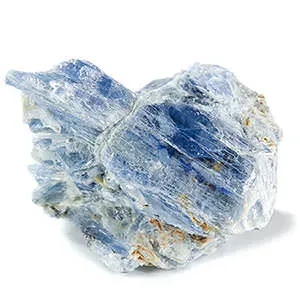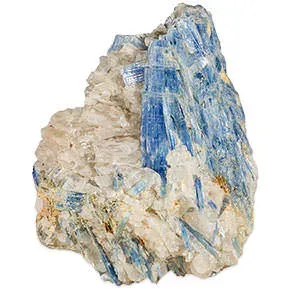 Kyanite is an aluminum silicate. The name kyanite derives from the Greek word Kyanos, meaning blue. Kyanite is used in the manufacturing of spark plugs as well as in ceramic products, including dishes and plumbing fixtures. Kyanite is quite a unique stone, in that it has a wide variation of hardness across the same crystal. It rates a 4.5 on the hardness scale along the length of the crystal, and a 7 across the width. This is the most useful characteristic when trying to identify kyanite. Because of this rare variation in hardness, kyanite is also known as disthene. Kyanite is quite an attractive mineral, however it is infrequently used as a gemstone in jewelry as it is quite brittle. The fibrous nature of kyanite crystals, as well as its cleavage, makes it liable to break along its length. Its brittleness means that extreme care must be taken when handling, cutting and polishing the stone. Kyanite has perfect cleavage in one direction and is vitreous, and transparent to translucent.
Kyanite is an aluminum silicate. The name kyanite derives from the Greek word Kyanos, meaning blue. Kyanite is used in the manufacturing of spark plugs as well as in ceramic products, including dishes and plumbing fixtures. Kyanite is quite a unique stone, in that it has a wide variation of hardness across the same crystal. It rates a 4.5 on the hardness scale along the length of the crystal, and a 7 across the width. This is the most useful characteristic when trying to identify kyanite. Because of this rare variation in hardness, kyanite is also known as disthene. Kyanite is quite an attractive mineral, however it is infrequently used as a gemstone in jewelry as it is quite brittle. The fibrous nature of kyanite crystals, as well as its cleavage, makes it liable to break along its length. Its brittleness means that extreme care must be taken when handling, cutting and polishing the stone. Kyanite has perfect cleavage in one direction and is vitreous, and transparent to translucent.
 The better quality stones are more translucent. In the rare cases when kyanite is used in jewelry, the most prized stones are transparent and deep cornflower blue, pale blue, or bluish green in color. In general however, kyanite ranges in color from pale to deep blue and green, brown, white, and gray. Color distribution may be uneven within the stone, with darker blue patches seen towards the center of the crystal, and white or colorless patches towards the edge. Kyanite can be mistaken for
The better quality stones are more translucent. In the rare cases when kyanite is used in jewelry, the most prized stones are transparent and deep cornflower blue, pale blue, or bluish green in color. In general however, kyanite ranges in color from pale to deep blue and green, brown, white, and gray. Color distribution may be uneven within the stone, with darker blue patches seen towards the center of the crystal, and white or colorless patches towards the edge. Kyanite can be mistaken for ![]() sapphire and
sapphire and ![]() aquamarine. It is often fashioned into long rectangular and step cuts or into oval cabochons and sometimes has magnetic properties similar to tourmaline.
aquamarine. It is often fashioned into long rectangular and step cuts or into oval cabochons and sometimes has magnetic properties similar to tourmaline.
 Kyanite occurs typically in metamorphic rocks such as schist and gneiss, as well as in pegmatite veins. It is often found in groupings of light blue crystals with variations in the depth of blue. It may also be weathered out into alluvial deposits. Kyanite is associated with the minerals andalusite, sorundum and staurolite. It is extracted from alluvial deposits at Villa Rica, Brazil. Rare, colorless kyanite is found at Machakos, Kenya. Very fine kyanite crystals, found in association with staurolite, are found in the schists of St Gotthard, in the Tyrol Mountains of Switzerland. Other major locations for kyanite are Switzerland, Yugoslavia, Kenya, India, Myanmar, the European Alps, and Australia. Kyanite can also be found in the United States, in Yancey County, North Carolina, Madison County, Montana, and various locations around Massachusetts and North Carolina.
Kyanite occurs typically in metamorphic rocks such as schist and gneiss, as well as in pegmatite veins. It is often found in groupings of light blue crystals with variations in the depth of blue. It may also be weathered out into alluvial deposits. Kyanite is associated with the minerals andalusite, sorundum and staurolite. It is extracted from alluvial deposits at Villa Rica, Brazil. Rare, colorless kyanite is found at Machakos, Kenya. Very fine kyanite crystals, found in association with staurolite, are found in the schists of St Gotthard, in the Tyrol Mountains of Switzerland. Other major locations for kyanite are Switzerland, Yugoslavia, Kenya, India, Myanmar, the European Alps, and Australia. Kyanite can also be found in the United States, in Yancey County, North Carolina, Madison County, Montana, and various locations around Massachusetts and North Carolina.
 Kyanite contains the virtue of self-healing. It is a stone that is useful for those who are working to take responsibility for their own health. It helps the wearer develop a better sense of their poor health conditions, concerning matters of emotional weariness, physical fatigue, or the results of an imbalanced diet. Kyanite also possesses virtues of calm and tranquility, and is therefore useful for those who have difficulty with meditation. Kyanite is also used to embrace love and encourages us to take risks for love.
Kyanite contains the virtue of self-healing. It is a stone that is useful for those who are working to take responsibility for their own health. It helps the wearer develop a better sense of their poor health conditions, concerning matters of emotional weariness, physical fatigue, or the results of an imbalanced diet. Kyanite also possesses virtues of calm and tranquility, and is therefore useful for those who have difficulty with meditation. Kyanite is also used to embrace love and encourages us to take risks for love.